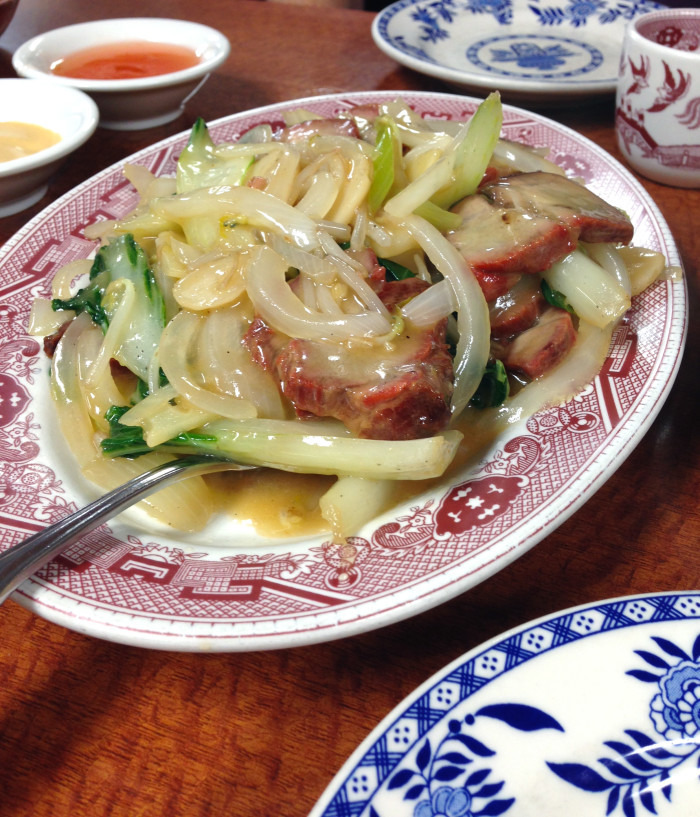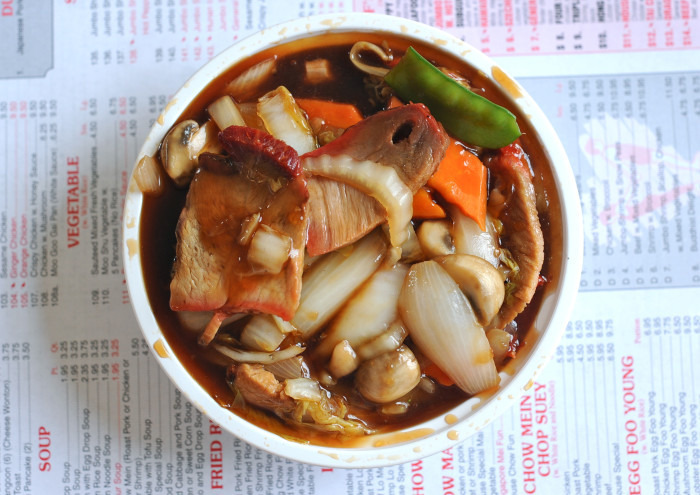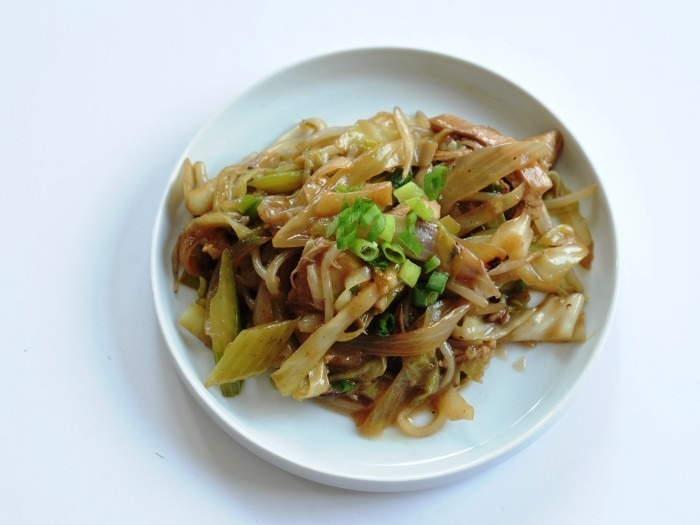What Is Chop Suey?
On a nondescript corner in Manhattan's Chinatown and down a flight of stairs, beneath the pavement packed with busy Asian shoppers and curious tourists alike, is a place where you can travel back in time: Hop Kee on Mott Street, a subterranean restaurant serving what many Americans might describe as old-school Chinese food.
"It's one of the few old-time Taishanese restaurants," says Andrew Coe, sitting across from me in one of the venue's burgundy-colored booths. "They were the first Chinese people who came here."
The décor is simple and outdated, and the florescent lights are a bit much. We watch steaming piles of Cantonese-style crabs and whole fish fly past us, but we won't be eating any of that. We are here to eat one dish: chop suey.
Sure, you've probably heard the term. But if you never picked up chopsticks during the middle of the last century, you probably haven't tried chop suey and don't know much else about it.
That's precisely why we're here. Coe, dressed smartly in a polo shirt, jeans and glasses, is the author of Chop Suey: A Cultural History of Chinese Food in the United States. Published in 2009, Coe's book is one of at least two existing cultural histories of Chinese food in the U.S. to mention chop suey in the title — a funny coincidence that nicely demonstrates just how popular and ubiquitous this particular dish used to be.
As Coe writes in his book, "Today, chop suey is a relic in most parts of the United States, another food fad that has ended up on the trash heap of culinary history. Those who remember it at all know it only as a preparation of sliced pork or chicken cooked with bean sprouts, onions, celery, bamboo shoots, and water chestnuts until everything is mushy and flavorless, then served with a gummy, translucent sauce over white rice."
Luckily for our purposes, there remain a few unfashionably antiquated locations that still serve the dubious-sounding dish, Hop Kee being one. In fact, the restaurant offers four varieties of the stuff: beef, chicken, roast pork and shrimp. We order the pork.
So what is chop suey exactly? That's what Coe himself wanted to know several years ago when he was doing research at the New York Public Library for another book on the city's history and noticed something curious. "I had seen this photograph of Chinatown in the 1940s, and all the restaurants had signs saying 'Chop Suey,'" he says. "I thought, where did this come from and where did it go?" The question begged for further investigation. "You see these signs, you do all the research and you realize that chop suey was one of the most popular foods in America," Coe says. "Everybody served it. From U.S. Army mess halls to cafés out in rural Oklahoma, everybody had chop suey. How did this happen?"
Around this time, Coe is interrupted mid-sentence by the arrival of our food. Behold: chop suey!
What appears in front of us is very much like Coe described in his book: a basic stir-fry of meat and vegetables coated in a simple gravy thickened with cornstarch. But Hop Kee's version is not "mushy and flavorless," as I'm pleasantly surprised to discover. There are sizable chunks of roast pork, as well as the standard celery, onions and bean sprouts, but the sauce is not gloppy. It's shimmery and has a deep flavor, like a consommé of your grandmother's chicken soup. Before me is the quintessential Chinese-American dish, the first gateway drug for America's growing addiction to Chinese food.
"This is not bad," Coe says.

It Came From San Francisco
Creation myths abound about chop suey's mysterious rise to fame in the early 20th century. In many ways, the story of the dish is also the story of Chinese immigration to the U.S.
The first Chinese immigrants began to arrive in California during the Gold Rush in the late 1840s. They were mostly poor male laborers who worked first as gold miners, then later on the First Transcontinental Railroad. Most didn't speak English, and with no reason to assimilate into the violently racist population, they largely kept to themselves and set up small communities with restaurants, Laundromats and grocery stores. The first Chinatowns appeared along the railway line in places like San Francisco and Portland. Some daring whites tried Chinese delicacies of shark's fin soup and swallow's nest soup, but Coe writes that "it became politically and socially dangerous to admit to having a taste for Chinese cuisine" as fear that the Chinese were taking valuable jobs escalated. By the 1860s, damaging "firsthand" accounts of Chinese people eating rats appeared in newspapers, and a general xenophobia set in.
"There were all these rumors about how chop suey was born," says Coe. In one tale from his book, an American businessman claims that late one night a group of white miners decided to finally try Chinese food. They arrived just as the doors were shutting, and the cook, wanting to avoid trouble, threw all the leftovers in a bowl with a thick sauce and served it. In this myth, Americans are the butt of a Chinese joke, eating the leftovers or "beggar's hash," which we now call chop suey.
This lighthearted tale reflects nothing of the reality of racism and mistreatment of the Chinese people throughout the West, culminating in a violent attack in Rock Springs, Wyoming, that left 28 Chinese people dead. In 1882, President Chester A. Arthur signed the Chinese Exclusion Act, which barred anyone from China from entering the U.S. It was law until 1943, when it was repealed by the Magnuson Act because the U.S. needed China's help defeating the Japanese during World War II. It's important to know the history of the mistreatment of early Chinese immigrants in America to understand how the single dish of chop suey wormed its way into the stomachs and hearts of the population.
While the dish originated in San Francisco, another pivotal moment in the history of chop suey took place in New York City, where many Chinese immigrants came in the years following the Gold Rush, establishing a small community along Mott Street near Chatham Square in downtown Manhattan.
In 1886, a high-ranking Chinese official named Li Hongzhang visited the United States in an attempt to improve relations between the two countries. "He was the most important Chinese statesman to have visited the United States up to that point," says Coe. "It was a huge media event throughout the country. His parade was right here on Mott Street." Americans were fascinated by this regal aging man, and newspapers like William Randolph Hearst's New York Journal and The Brooklyn Eagle reported every move he made and every bite he took. According to Coe's book, the Washington Post even falsely reported that he ate chop suey because it was the only Chinese dish that most American readers would recognize. But Li never actually ate the dish; it was just that chop suey was a dish familiar to newspaper readers and "emblematic of Chinese food as a whole," writes Coe.
It's clear that people had been eating the dish years before Li arrived, likely back in China as well. But his visit sparked an obsession with Chinese food in America. Enterprising Chinese restaurateurs from San Francisco to Chicago to New York opened "chop sueys" or "chop suey joints," serving the dish as part of an Americanized menu. White Americans had settled on a dish that was familiar to them but with a tinge of the exotic, and the dish became a national sensation. For much of the 20th century, this single dish was synonymous with Chinese food for most Americans. It is largely responsible for our love and dependence on cheap Chinese food.
According to Coe, this "Golden Age of Chop Suey" lasted from about 1920 to 1960.

Where Did It Go?
In many ways, the same phenomenon that led to the creation and popularization of chop suey in America has also played a big role in its demise: immigration.
When immigration quotas were finally lifted by the Immigration Act of 1965, a new wave of Chinese immigrants came to the United States, many of them from different parts of China, including Hunan and Sichuan provinces. Like their Taishanese forebears, these people brought with them their own styles of Chinese cooking.
American palates were suddenly exposed to different cuisines with bolder flavors. Tastes expanded, and over time, Americans have grown to love things like tingly peppercorns and hot pots. Chop suey was left in the dust, forgotten in major cities and only still popular in isolated suburbs.
"Some foods from this era have a retro appeal, but there's none whatsoever with chop suey," says Coe, who blames our new sophisticated palates and disdain for gloppy sauces.
"Tiki bars and pupu platters are still around because people love fried food. That, people go for," he says. "But the combination of flavors and textures of chop suey just doesn't happen for people anymore."
Once a hallmark of adventurous ethnic eating, chop suey has fallen far off the cultural radar. Restaurants that sprung up to capitalize on the onetime trend have largely disappeared. Coe points to the defunct Jade Mountain, a chop suey joint in New York's East Village, which closed down three or four years ago. "Their chop suey was just so tired-looking. It was gray, with mostly water chestnuts, and everything was overcooked," he says.
Today, Chinese food is probably more popular than ever in the U.S. What was once thought of as slop with rat meat (thanks to early xenophobic accounts) is now a respected and influential cuisine. With its myriad regional cooking styles, Chinese food is an especially attractive obsession for the type of passionate foodies who make it their mission to hunt down the tastiest and most "authentic" foods of all kinds. Amid this growing tolerance for the spicy numbness of Sichuan peppercorns and greater appreciation for the aromatic flavor of tea-smoked duck, a comparatively bland stir-fry like chop suey, such as it is, can't really compete.
Will it ever make a comeback? Possibly, but probably not without a modern touch.
My suggestion: Ask for a generous helping of chopped scallions and a healthy dose of chili oil.


